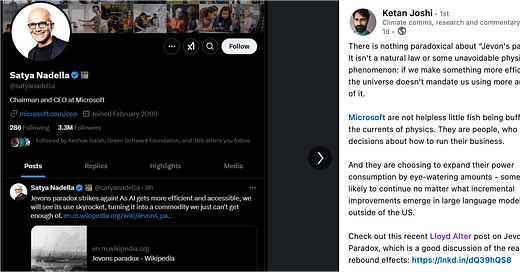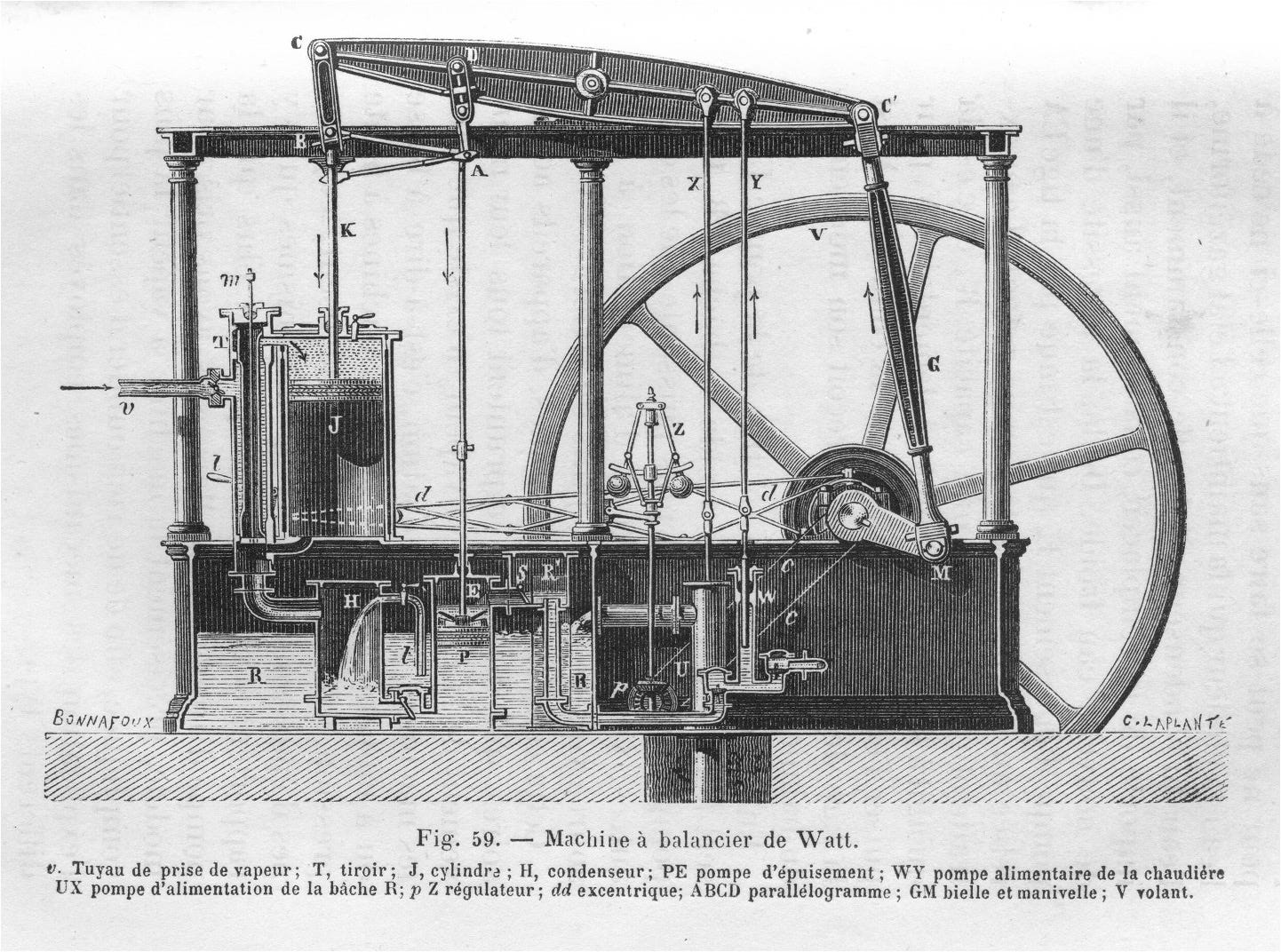Stanley's back! Jevons' Paradox comes to AI with DeepSeek
We have seen this movie before, from steam engines to LEDs.
After DeepSeek announced an AI model that purportedly was built with less money, older and fewer chips, and running on less energy, Satya Nadella, the Chairman and CEO of Microsoft, tweeted:
"Jevons paradox strikes again!"As AI gets more efficient and accessible, we will see its use skyrocket, turning it into a commodity we just can't get enough of."
Suddenly, everyone is talking about W. Stanley Jevons and his so-called paradox. I have been writing and teaching about Jevons (most recently here) for so long that I feel I am on a first-name basis. It is a touchy subject because Jevons has been misunderstood and misused. But in this case, Nadella nails it. Here is the backstory:
In 1712, Thomas Newcomen introduced the Atmospheric Engine, the first useful steam engine. It was used to pump water out of coal and metal mines and was not good for much else; it was so inefficient and used so much coal that it had to essentially sit on top of the mine.
In 1765, James Watt introduced the condensing steam engine, which added an external condenser, reducing the heat loss from repeatedly heating and cooling the cylinder and piston. This reduced fuel consumption by 75%. However, this did not lead to a 75% reduction in the amount of coal burned.
Watt and his new partner, Matthew Boulton, continuously improved the engine, including the development of rotary motion, which made it suitable for use in factories and mills. It also led to an explosion of experimentation and a vast expansion in the use of steam engines.
In 1803, William Symington put a steam engine in a boat and launched the Charlotte Dundas, the first practical steamship. Robert Fulton saw the boat and took the ideas back to the USA, where he is often credited with inventing the steamboat in 1807. He didn’t, but he did make it commercially viable and revolutionized river transport and trade in the USA.
In 1804, James Trevethick developed a high-pressure steam engine that was small and efficient enough to put on wheels to make the first practical locomotive, marking the beginning of steam-powered transport.
Steam engines got bigger and ran factories and mills; they got smaller and ran trains and boats; they got cheaper, and they got more efficient, yet they kept needing more coal as people kept figuring out amazing new ways to use them.
In 1865, W. Stanley Jevons worried about where all this coal was going to come from, noting that even as steam engines got more efficient, demand would keep increasing. He wrote in The Coal Question:
“There is hardly a single use of fuel in which a little care, ingenuity, or expenditure of capital may not make a considerable saving. But no one must suppose that coal thus saved is spared – it is only saved from one use to be employed in others, and the profits gained soon lead to extended employment in many new forms.”
This is the crux of Jevons’ Paradox: a technological breakthrough that dramatically reduced the energy consumption of the steam engine did not lead to savings of energy overall, but instead caused an explosion of its usefulness and the first industrial revolution. Putting it on wheels and connecting generators to it gave us the second technological revolution. As Jevons noted:
“Whatever, therefore, conduces to increase the efficiency of coal, and to diminish the cost of its use, directly tends to augment the value of the steam-engine, and to enlarge the field of its operations.”
But there are two sides to Jevons. He also wrote that when a resource gets more expensive, we use it more carefully. “It is true that where fuel is cheap, it is wasted, and where it is dear it is economized.” People get clever and adapt. I wrote in my book “Living the 1.5 Degree Lifestyle:”
As lithium supplies tighten and the costs go up, batteries get new chemistries that use less lithium
,and get greater energy density. They are also being used, as Jevons predicted, in many new forms; we have seen the explosion in micromobility, with e-bikes, scooters, and minicars doing the same job of moving people with a fraction of the materials.
This is what DeepSeek appears to have done; they couldn’t get vast numbers of the best new chips, so they figured out how to do more with less. A lot less.
Which brings us back to Satya Nadella, who is pointing out that dramatic reduction in cost and energy consumption will lead to an explosion in the use of AI. But it is a bit like Monty Python’s The Life of Brian, “Always look on the bright side of life” here, because Microsoft has invested $40 billion in AI, including $13 billion in OpenAI, much of which may have just turned to dust. As Ed Zitron writes,
DeepSeek's biggest, ugliest insult is that its model, DeepSeek R1, is competitive with OpenAI's incredibly expensive o1 "reasoning" model, yet significantly (96%~) cheaper to run, and can even be run locally. Speaking to a few developers I know, one was able to run DeepSeek's R1 model on their 2021 MacBook Pro with an M1 chip. Worse still, DeepSeek’s models are made freely available to use, with the source code published under the MIT license, along with the research on how they were made (although not the training data), which means they can be adapted and used for commercial use without the need for royalties or fees… Now the markets are asking a very reasonable question: “did we just waste $200 billion?”
Stanley Jevons tells us that we will have an explosion in innovation and use of AI as almost anyone can play with it now. We might even have a worse water and electricity problem as AI turns into Bitcoin, with thousands of small operators firing up their NVIDIA chips connected to dirty coal power sources. We might well need some kind of regulation and limits, and to think about sufficiency, about how much of this we actually need. DeepSeek may be more efficient, but as Samuel Alexander noted, “efficiency without sufficiency is lost.”
Jevons also noted that the wealth generated by all this innovation should not be pocketed by the likes of Elon Musk, Sam Altman, or even Satya Nadella:
Reflection will show that we ought not to think of interfering with the free use of the material wealth which Providence has placed at our disposal, but that our duties wholly consist in the earnest and wise application of it. We may spend it on the one hand in increased luxury and ostentation and corruption, and we shall be blamed. We may spend it on the other hand in raising the social and moral condition of the people, and in reducing the burdens of future generations. Even if our successors be less happily placed than ourselves they will not then blame us.
Jevons’ Britain ran on coal and he worried what would happen when it ran out; Britain might not be able to control the alternatives, much like the USA today tries to control and hold back alternatives to oil. He quotes Professor Tyndall in the second edition:
“I see no prospect of any substitute being found for coal, as a source of motive power. We have, it is true, our winds and streams and tides; and we have the beams of the sun. But these are common to all the world. We cannot make head against a nation which, in addition to those sources of power, possesses the power of coal.”
So now, the USA has to make head against a nation that not only harvests the beams of the sun with their solar panels but also possesses the power of AI. We live in interesting times, much of which was predicted by W. Stanley Jevons.
I have written a great deal about Stanley Jevons, in particular about the paradox of LEDs, which are now used in a million ways nobody ever imagined. Read more:
Stanley Jevons goes to Las Vegas- The Sphere eats up the energy and carbon savings from converting 47,889 houses to LED lighting; a bright example of Jevons' Paradox.
Even with LEDs and e-bikes, we have to ask how much we need and what is enough. "Efficiency without sufficiency is lost."











Lloyd, I have seen dozens of stories about AI and Jevon's Paradox in the past week. None explains the past history and likely future of AI as clearly as you have done. Kudos!
"So now, the USA has to make head against a nation that not only harvests the beams of the sun with their solar panels but also possesses the power of AI."
And yet, there is this about China (Perplexity):
>> "Based on the most recent data available as of January 31, 2025, China has 1,161 operational coal-fired power plants"
Add to that, purportedly, 2 additional coal fired plants/week: https://insights.taylorenglish.com/post/102iw50/china-is-building-coal-fired-power-plants-at-an-alarming-rate
Taylor English: https://insights.taylorenglish.com/post/102iw50/china-is-building-coal-fired-power-plants-at-an-alarming-rate
"During the first six months of 2023, China issued permits for the construction of approximately 50 new coal-fired power plants, an average of two per week. China currently has more than 300 coal-fired plants that are either under construction, permitted, or awaiting permitting. If all 300 plants are constructed, China’s inventory of coal-fired power plants will increase by more than 25%.
Currently, China has six times more coal-fired power plants under construction than the rest of the World combined"
So, Lloyd, it isn't just "beams of the sun" - it's a WHOLE lot of fossil fuels. China's marketing is rather slick. China may be the leader in RE but they are the LEADER of coal and emissions.
In essence, the West could "hovel" itself and it wouldn't make a dang worth of difference in the use of coal. And India is right behind them.